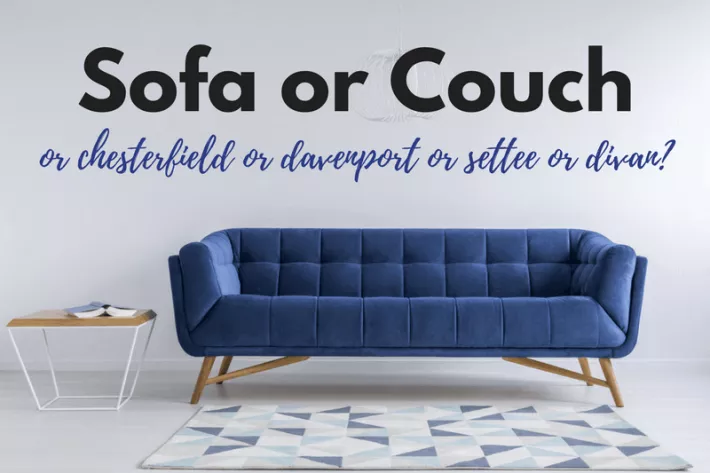What you call a long, upholstered piece of living room furniture depends on where you live and when you were born.
‘Davenport’
For example, “couch” and “sofa” are currently the most popular names, but my parents called it a davenport because that name was once common in the upper Midwest, which is where my parents grew up. The name came from the A.H. Davenport Company, a manufacturer of this type of furniture in the mid-1800s and into the early 1900s, including pieces that furnished the White House. From a Google Ngram search in books, it looks as if “davenport” peaked in the United States in the mid-1940s after which its use dropped dramatically and then has been stable at a lower rate since around 1970.
Usage of ‘Couch’ and ‘Sofa’
In 2009, I posted a nonscientific online poll asking what you call a long, upholstered piece of furniture, and nearly 4,500 people replied. “Couch” was the clear winner with 71% of the responses, “sofa” was next with 27% of the responses, and all the others had fractions of a percent:
- Couch 71.1%
- Sofa 26.6%
- Chesterfield 0.8%
- Settee 0.8%
- Davenport 0.6%
- Divan 0.3%
Some people told me that “lounge” (which I neglected to include in the poll) is a dominant term in Australia.
Anecdotally, I’ve seen the assertion that “sofa” is proper, and “couch” is slang, but I couldn’t find any data or reference books to back that up. It may simply come from the fact that “sofa” is more popular in Britain, and “couch” is more popular in the United States, and some British people consider American terms to be less proper. Also, “couch” probably won so dramatically in my online poll because the respondents skewed American.
There may also be differences by class, at least in Britain, that didn’t show up in my poll. For example, I found a linguistics corpus study that says middle class people in Britain were more likely to use “sofa” or “couch,” whereas working class people were more likely to use “settee.”
Origin of ‘Couch’ and ‘Sofa’
Dictionaries say that “couch” is actually the older term and has been around since Middle English (as “couche”) and comes from an Old French (“culche”) word meaning “to put into place,” “to lie down,” or “to put into bed.”
“Sofa” made its appearance in English at least a couple hundred years later, coming from the Arabic word “soffah” or “suffah” which originally meant “a bench.” “Sofa” came to describe the piece of furniture we think of today in the early 1700s.
In the old days, a couch may or may not have had a back or may have had a half-back , and may have had only an armrest on one end or had a raised end such as a psychiatrist’s couch, but my impression is that today, “sofa” and “couch” are both regularly used to describe furniture that has both a back and arms.
Examples of ‘Chesterfield’
Some responses to the poll led me to believe that “chesterfield” is more popular in Canada than in the U.S. and may also have some traction in California, and some online searching further convinced me that “chesterfield” is more popular in Canada than in the U.S. For example, here’s a line from a book called “Melanie Bluelake’s Dream,” written in 1995 by a Saskatchewan teacher named Betty Fitzpatrick Dorion:
- While Rachel jacked up the thermostat, Melanie curled up in a shivering ball on the chesterfield.
And here’s another example from nonfiction book called “Growing Up: Childhood in English Canada from the Great War to the Age of Television” by Neil Sutherland. In this example a woman is taking about her grandmother and says
- I always came and sat right beside her on the chesterfield to watch TV.
Dictionary.com also notes that “chesterfield” is “chiefly Canadian.” Unfortunately, Google Ngram searches only let me filter by British English and American English, so I can’t track Canadian trends over time, but I did find a linguistics study that says “chesterfield” in Canada is much like “davenport” in the United States: it was a common term years ago and is still sometimes used by older people, but among younger Canadians, “couch” is the common term.
Multiple sources say the furniture gets its “chesterfield” name from the nineteenth century Earl of Chesterfield, Lord Phillip Stanhope, who may have commissioned a long seat with “deep buttoned upholstery, rolled arms, and equal back and arm height” so his noble visitors would have a comfortable place to sit.
Summary
To sum up, “couch” and “sofa” are currently by far the most popular terms in the U.S. and the U.K. British writers appear to favor “sofa,” and American writers appear to favor “couch”; and you may occasionally hear “divan,” “settee,” “chesterfield,” and “davenport,” especially among older people.
Finally, for a bit of fun, I laughed at this argument one respondent made to prove that the correct term is “couch.” He asked, “Who ever heard of a sofa potato?”
Image courtesy of Shutterstock.
Mignon Fogarty is Grammar Girl and the founder of Quick and Dirty Tips. Check out her New York Times best-seller “Grammar Girl’s Quick and Dirty Tips for Better Writing” and her 2018 tip-a-day calendar.




